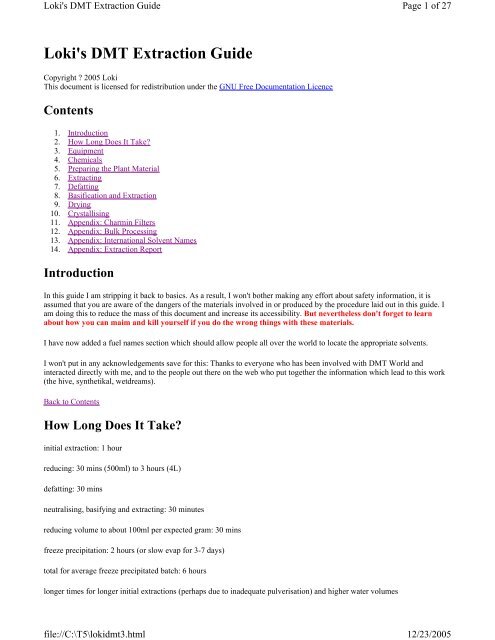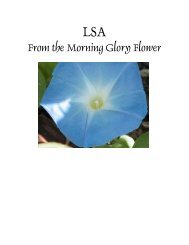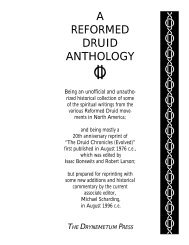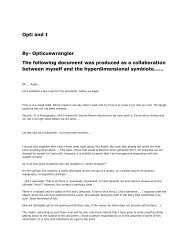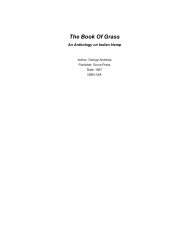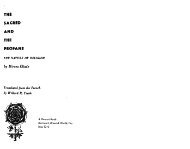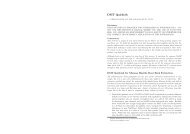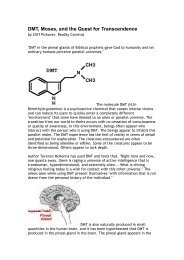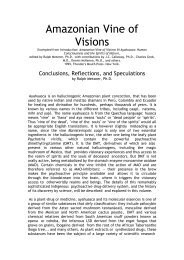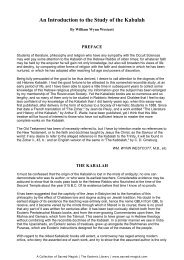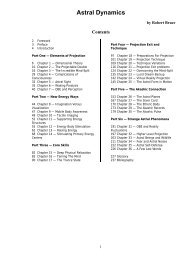Loki's DMT Extraction Guide - the DMT-Nexus
Loki's DMT Extraction Guide - the DMT-Nexus
Loki's DMT Extraction Guide - the DMT-Nexus
Create successful ePaper yourself
Turn your PDF publications into a flip-book with our unique Google optimized e-Paper software.
<strong>Loki's</strong> <strong>DMT</strong> <strong>Extraction</strong> <strong>Guide</strong><br />
<strong>Loki's</strong> <strong>DMT</strong> <strong>Extraction</strong> <strong>Guide</strong><br />
Copyright ? 2005 Loki<br />
This document is licensed for redistribution under <strong>the</strong> GNU Free Documentation Licence<br />
Contents<br />
1. Introduction<br />
2. How Long Does It Take?<br />
3. Equipment<br />
4. Chemicals<br />
5. Preparing <strong>the</strong> Plant Material<br />
6. Extracting<br />
7. Defatting<br />
8. Basification and <strong>Extraction</strong><br />
9. Drying<br />
10. Crystallising<br />
11. Appendix: Charmin Filters<br />
12. Appendix: Bulk Processing<br />
13. Appendix: International Solvent Names<br />
14. Appendix: <strong>Extraction</strong> Report<br />
Introduction<br />
In this guide I am stripping it back to basics. As a result, I won't bo<strong>the</strong>r making any effort about safety information, it is<br />
assumed that you are aware of <strong>the</strong> dangers of <strong>the</strong> materials involved in or produced by <strong>the</strong> procedure laid out in this guide. I<br />
am doing this to reduce <strong>the</strong> mass of this document and increase its accessibility. But never<strong>the</strong>less don't forget to learn<br />
about how you can maim and kill yourself if you do <strong>the</strong> wrong things with <strong>the</strong>se materials.<br />
I have now added a fuel names section which should allow people all over <strong>the</strong> world to locate <strong>the</strong> appropriate solvents.<br />
I won't put in any acknowledgements save for this: Thanks to everyone who has been involved with <strong>DMT</strong> World and<br />
interacted directly with me, and to <strong>the</strong> people out <strong>the</strong>re on <strong>the</strong> web who put toge<strong>the</strong>r <strong>the</strong> information which lead to this work<br />
(<strong>the</strong> hive, syn<strong>the</strong>tikal, wetdreams).<br />
Back to Contents<br />
How Long Does It Take?<br />
initial extraction: 1 hour<br />
reducing: 30 mins (500ml) to 3 hours (4L)<br />
defatting: 30 mins<br />
neutralising, basifying and extracting: 30 minutes<br />
reducing volume to about 100ml per expected gram: 30 mins<br />
freeze precipitation: 2 hours (or slow evap for 3-7 days)<br />
total for average freeze precipitated batch: 6 hours<br />
longer times for longer initial extractions (perhaps due to inadequate pulverisation) and higher water volumes<br />
file://C:\T5\lokidmt3.html<br />
Page 1 of 27<br />
12/23/2005
<strong>Loki's</strong> <strong>DMT</strong> <strong>Extraction</strong> <strong>Guide</strong><br />
Back to Contents<br />
Equipment<br />
The key equipment in this process is <strong>the</strong> separating device, which can be a baster/pipette, syringe, separatory funnel etc.O<strong>the</strong>r<br />
than that one will need a lot of jars/flasks (pyrex is preferable for laboratory work) possibly a couple of cooking pots, heating<br />
device, and filtration equipment (thrift shops and coffee making devices are a good source for this), and an electric fan. An<br />
adequately ventilated space to work in is essential, this can be augmented with an electric fan.<br />
file://C:\T5\lokidmt3.html<br />
Page 2 of 27<br />
<strong>Loki's</strong> <strong>DMT</strong> <strong>Extraction</strong> <strong>Guide</strong><br />
Back to Contents<br />
Chemicals<br />
The following is a list of chemicals you will need:<br />
Alternatives:<br />
Back to Contents<br />
Lye<br />
Sodium hydroxide or potassium<br />
hydroxide, solution with ei<strong>the</strong>r and water<br />
at about 120g/L (about 6 teaspoons per<br />
250ml) NaOH or 170g/L KOH<br />
(potassium hydroxide solutions can be<br />
found at hydroponic stores).<br />
DANGER: CORROSIVE, BURNS TO<br />
EYES CAN CAUSE BLINDNESS<br />
Calcium Ascorbate<br />
this is used to precipitate tannins and while<br />
<strong>the</strong>re is alternatives (o<strong>the</strong>r calcium salts, in<br />
particular), this should be available to<br />
anyone.<br />
� can be made from calcium hydroxide:ascorbic acid<br />
74:176 weight ratio or 100:176 using calcium<br />
carbonate instead.<br />
� calcium acetate: make <strong>the</strong> solution with 500ml white<br />
vinegar, 30g of calcium carbonate (or about 22g of<br />
calcium hydroxide) and 500ml of water<br />
� calcium phosphate monobasic, which is 74:98 with<br />
calcium hydroxide and 100:98 with calcium<br />
carbonate, calculate weight of phosphoric acid in <strong>the</strong><br />
phosphoric acid solution (% translate to <strong>the</strong> number<br />
times 10 in grams per litre, sometimes it is shown in<br />
weight/volume, grams/L) and mix <strong>the</strong> two<br />
appropriately to produce a solution with 30g CaCO 3<br />
(or 22g Ca[OH] 2 ) per litre of solution.<br />
Toluene/Xylene/Hexane<br />
For defatting, a more strong general<br />
solvent is required. Naptha/heptane type<br />
mixes can be used but expect to need 2-<br />
3x as much.<br />
DANGER: HIGHLY FLAMMABLE<br />
NO FLAMES OR SPARKS<br />
Page 3 of 27<br />
Carbonate Salt<br />
Sodium carbonate or sodium bicarbonate<br />
would both work here, as would calcium<br />
carbonate, this is used for neutralisation<br />
because you can see neutrality by <strong>the</strong> lack of<br />
frothing. Sodium carbonate should be<br />
ground up before using it.<br />
Naptha/Shellite/Coleman<br />
Fuel/Heptane/Hexane<br />
For extraction. Any of <strong>the</strong>se should be fine, if<br />
hexane is used, you can probably halve <strong>the</strong><br />
quantities specified as <strong>the</strong>se are all adjusted to<br />
average naptha type mixtures. See Appendix:<br />
International Solvent Names to locate a local<br />
equivalent.<br />
If that doesn't help, a few clues - it is also a<br />
lighter fluid (zippo is much <strong>the</strong> same) and<br />
used for liquid fuel camp stoves. If you know<br />
fire twirling freaks <strong>the</strong>y will be able to tell you about <strong>the</strong><br />
different fuels that can go into a fire blend, naptha is<br />
commonly added to mixes to increase how hot it burns.<br />
DANGER: HIGHLY FLAMMABLE NO FLAMES OR<br />
SPARKS<br />
Anhydrous Epsom Salts<br />
Can be made by sitting Epsom Salts<br />
(magnesium sulphate: MgSO4) in 250<br />
degree C oven for about 1 hour or if<br />
impatient, a thin layer on a pyrex dish in<br />
<strong>the</strong> microwave for 3 minutes, which has to<br />
be broken up in ei<strong>the</strong>r case afterwards (be<br />
careful not to break <strong>the</strong> glass as when it's hot it's more prone<br />
to breaking).<br />
Rock Salt<br />
Brine Wash Solution<br />
Get <strong>the</strong> stuff that's chunky, table salts usually have Brine means concentrated salt solution. 36g of NaCl (rock<br />
alumina-silicate and iodides in <strong>the</strong>m which, while salt) saturates 100ml of water. You may need to boil <strong>the</strong><br />
not in great quantities, are just plain not needed water or grind <strong>the</strong> salt to get it to dissolve properly. Make<br />
and are not present in rock salt. Sea salt and sure you use it to do <strong>the</strong> brine wash when it is at room<br />
Kosher salt are both also fine.<br />
temperature. Add a slight excess of salt to what is required<br />
and it can be decanted off or filtered out anyway, whatever is<br />
liquid is concentrated sodium chloride solution.<br />
file://C:\T5\lokidmt3.html<br />
12/23/2005
<strong>Loki's</strong> <strong>DMT</strong> <strong>Extraction</strong> <strong>Guide</strong><br />
Preparing <strong>the</strong> Plant Material<br />
First step is <strong>the</strong> plant material. The ideal treatment is for it to be bone dry and ground to powder. The less like a powder it is,<br />
<strong>the</strong> more time it will need during <strong>the</strong> initial boil to get everything out. The best tool for this is a powerful glass blender, 600-<br />
700W power ones are <strong>the</strong> best. This guide will assume one has dry powdery material to work with.<br />
Back to Contents<br />
Extracting<br />
<strong>Extraction</strong> solution volume is worked out based on <strong>the</strong> weight of <strong>the</strong> substance being extracted from, for 500g about 4L of<br />
solution will be required. The solution is made with 50g of calcium ascorbate.<br />
Why is calcium ascorbate used? The calcium ascorbate splits, <strong>the</strong> calcium binds with <strong>the</strong> tannin and forms an<br />
insoluble precipitate and leaves behind <strong>the</strong> ascorbic acid, which has <strong>the</strong> added advantage of helping protect <strong>the</strong><br />
solution from oxidation. The ascorbic acid this process leaves behind maintains <strong>the</strong> acidity of <strong>the</strong> solution to pretty<br />
much stay stable around 4 during <strong>the</strong> whole extraction process.<br />
A guide to <strong>the</strong> proportions with various weights of bark:<br />
Steps:<br />
100g bark, 800ml solution, 10g calcium ascorbate<br />
200g bark, 1600ml solution, 20g calcium ascorbate<br />
300g bark, 2400ml solution, 30g calcium ascorbate<br />
500g bark, 4000ml solution, 50g calcium ascorbate<br />
1000g bark, 8000ml solution, 100g calcium ascorbate<br />
1. Boil <strong>the</strong> solution for 20 minutes.<br />
2. Filter through coarse cloth to catch <strong>the</strong> bulk, and press <strong>the</strong> cloth ball flat after it has been drained, get every last<br />
possible drop out.<br />
3. Pour <strong>the</strong> solution though a fine strainer, which will catch a lot of intermediate sized particles.<br />
4. Boil solution down to 1/10th of <strong>the</strong> original volume.<br />
5. Refrigerate <strong>the</strong> solution (2 hours should be plenty). Decant <strong>the</strong> liquid off <strong>the</strong> top.<br />
6. Charmin filter (see charmin filter appendix) to remove <strong>the</strong> last of <strong>the</strong> particles.<br />
Back to Contents<br />
Defatting<br />
Defat <strong>the</strong> resulting solution 3x with 1/10th volumes of defatting solvent. Resolve emulsions using a container of hot water<br />
underneath <strong>the</strong> device/jar, and swizzling with a skewer. Defatting is a good idea because plants usually contain some fat as a<br />
critical part of <strong>the</strong>ir cellular membranes, and it removes essential oils that may be present as well.<br />
Defatting can be done with <strong>the</strong> assistance of heating too, <strong>the</strong> idea of dripping <strong>the</strong> aqueous solution into <strong>the</strong> solvent on a low<br />
heat as it is being finally filtered has been tested and seems to be a nice touch (some time ago <strong>the</strong> idea of doing <strong>the</strong><br />
extractions by dripping it through was put forward by someone and it is a good idea actually, condenses <strong>the</strong> defatting and<br />
filtration step into one.<br />
Back to Contents<br />
Basification and <strong>Extraction</strong><br />
Page 4 of 27<br />
First step is to neutralise <strong>the</strong> solution. By adding a carbonated base in dry powder form, one can add it slowly with stirring<br />
file://C:\T5\lokidmt3.html<br />
12/23/2005
<strong>Loki's</strong> <strong>DMT</strong> <strong>Extraction</strong> <strong>Guide</strong><br />
and when <strong>the</strong> evolution of carbon dioxide ceases, <strong>the</strong> solution is now unable to dislodge <strong>the</strong> carbonates and thus is<br />
approximately at neutral pH. It must be added slowly because <strong>the</strong> carbon dioxide evolution from <strong>the</strong> solution can be violent if<br />
it is added too fast. Once <strong>the</strong> solution ceases to respond with frothing it is neutralised.<br />
Next, put a quantity of naptha on top of <strong>the</strong> solution of about half <strong>the</strong> weight of <strong>the</strong> original bark, which results in <strong>the</strong><br />
following proportion table<br />
format: ml of naptha : g of bark (ml of aqueous extract)<br />
Steps:<br />
30ml:50g (40ml)<br />
60ml:100g (80ml)<br />
120ml:200g (160ml)<br />
180ml:300g (240ml)<br />
300ml:500g (400ml)<br />
600ml:1kg (800ml)<br />
1. Place a pyrex container containing this two phase mixture onto a sparkless heat source and slowly add <strong>the</strong> lye solution<br />
with stirring until <strong>the</strong> solution turns entirely black with no precipitate.<br />
2. Allow <strong>the</strong> solution to heat (gentle stirring is a good idea) until <strong>the</strong> solvent layer is clearly boiling and turn off <strong>the</strong> heat<br />
and quickly separate <strong>the</strong> two layers.<br />
Back to Contents<br />
Drying<br />
Next we dry <strong>the</strong> freebase extract in <strong>the</strong> solvent. This is done because all aqueous soluble junk from <strong>the</strong> solution that was just<br />
basified and extracted from is present in <strong>the</strong> small amount of water left, which, compared to <strong>the</strong> volume of product, is not<br />
trivial for what it can carry with it. When water is removed, most water-loving materials are removed as well, sodium<br />
hydroxide, and salts, and to a lesser degree, tannins (which are very water loving too).<br />
Steps:<br />
1. First is a brine wash, a 10% volume quantity of concentrated salt solution is mixed with shaking with <strong>the</strong> nonpolar<br />
solvent extract (naptha/heptane) and separated.<br />
2. Next, powdered drying agent (anhydrous epsom salts or sodium sulphate) is added to <strong>the</strong> nonpolar solvent until it<br />
ceases to take up water from <strong>the</strong> solution. The drying agent is filtered out, an ordinary coffee filter is usually enough<br />
but if you have particles still in <strong>the</strong> naptha a charmin filter may be neccessary.<br />
Back to Contents<br />
Crystallising<br />
Page 5 of 27<br />
Next step is to get <strong>the</strong> naptha/heptane extract to yield <strong>the</strong> <strong>DMT</strong> as a solid somehow. Old methods used to say to evaporate but<br />
it is in fact better to go straight to a crystallisation. There is two ways, freezing and slow evaporation. Freezing is faster but<br />
forms smaller finer crystals, slow evaporation produces larger crystals but takes longer.<br />
If one is freezing, <strong>the</strong> slower <strong>the</strong> process of cooling can be made to be, <strong>the</strong> bigger and purer <strong>the</strong> crystals will be. An insulated<br />
container or some kind of insulation around <strong>the</strong> crystallisation vessel is helpful for this. In my experience, <strong>the</strong> best<br />
crystallisation vessel is a squat beaker or a glazed ceramic bowl, sealed with polyethylene plastic (sarin) wrap.<br />
The slow evaporation method takes a lot longer but will produce larger more uniformly sized crystals. Basically one just<br />
takes <strong>the</strong> solution and allows it to evaporate by giving it a very small vent. Over <strong>the</strong> process of a week <strong>the</strong> naptha/heptane<br />
will evaporate and deposit crystals. Do not let it get to dry, stop it at <strong>the</strong> point where it appears that <strong>the</strong> solvent may be getting<br />
thick of something undesirable or o<strong>the</strong>rwise diminishing in ability to be decanted off, if this is done right it saves doing a<br />
second purification. One can always repeat <strong>the</strong> crystallisation process to get better purity, which usually involves a small<br />
file://C:\T5\lokidmt3.html<br />
12/23/2005
<strong>Loki's</strong> <strong>DMT</strong> <strong>Extraction</strong> <strong>Guide</strong><br />
amount of losses.<br />
Back to Contents<br />
Appendix: Charmin Filters<br />
The charmin filter is an indispensible filtration device for <strong>the</strong> clandestine chemist. Apparently it gets it's name from a<br />
particular brand of toilet paper - I have not seen this brand in Australia. Anyway, that's <strong>the</strong> reason behind <strong>the</strong> name.<br />
file://C:\T5\lokidmt3.html<br />
1.<br />
A funnel which is<br />
suitable for a charmin<br />
filter plug<br />
3.<br />
About two sheets is <strong>the</strong><br />
average amount<br />
needed<br />
5.<br />
fold <strong>the</strong> two sheets into<br />
one (fold on <strong>the</strong><br />
perforations)<br />
7.<br />
Fold in half again, so<br />
that <strong>the</strong> paper is longer<br />
than wide<br />
9.<br />
Roll <strong>the</strong> paper into a<br />
scroll...<br />
2.<br />
A roll of toilet paper<br />
suitable to pilfer from<br />
for making a charmin<br />
filter - this is a plain<br />
un-bleached recycled<br />
generic brand<br />
4.<br />
Tear two sheets off <strong>the</strong><br />
roll<br />
6.<br />
fold in half again<br />
8.<br />
Fold again and it will<br />
not really be possible<br />
to fold it again. About<br />
1cm wide is perfect<br />
10.<br />
Page 6 of 27<br />
...until it's a suitable<br />
size for <strong>the</strong> funnel (tear<br />
it if it is too big for <strong>the</strong><br />
funnel stem)<br />
12/23/2005
<strong>Loki's</strong> <strong>DMT</strong> <strong>Extraction</strong> <strong>Guide</strong><br />
Back to Contents<br />
Appendix: Bulk Processing<br />
If one is dealing with larger quantities at a time, it is advisable to pre-extract into alcohol to reduce <strong>the</strong> amount of energy<br />
required to get <strong>the</strong> solution to a workable volume. A simple way to ensure maximum efficiency is to put <strong>the</strong> plant material<br />
into a sort of cloth 'tea bag' so that one can pull <strong>the</strong> plant material out and easily press all <strong>the</strong> liquid out of it. About 20L of<br />
alcohol will be required to process about 4kg of plant material. Ethanol or methanol are both suitable, <strong>the</strong> choice will be<br />
dictated by availability and relative economics.<br />
1. After extracting this material, one would <strong>the</strong>n reduce <strong>the</strong> volume with heat and a fan in a space where ventilating a lot<br />
of alcohol will be ok and non-problematic. Methanol is somewhat less smelly but is more toxic, but will not have any<br />
denaturants.<br />
2. Once <strong>the</strong> solution is reduced to <strong>the</strong> point it starts to thicken up, filter <strong>the</strong> solution.<br />
3. Put <strong>the</strong> solution onto a steam bath (a pot of boiling water underneath) with a fan blowing over top to finish off <strong>the</strong><br />
evaporation. Let it dry until it is a hard solid, some breaking up and exposing of new surface may be required to<br />
expedite <strong>the</strong> process.<br />
4. The dry material at <strong>the</strong> end of <strong>the</strong> process can be treated just like <strong>the</strong> original plant material, although one may wish to<br />
use more calcium ascorbate if a lot of tannin comes through <strong>the</strong> alcohol extraction, due to <strong>the</strong>re being more tannins in<br />
<strong>the</strong> solution.<br />
The use of more solvent solvents for bulk extraction is highly advised also. Naptha, on average, requires about 20ml per gram<br />
to crystallise. If one was to be ending up with 50g (extracting from say 8kg), this would mean needing 1L of solvent to do <strong>the</strong><br />
crystallisation, but if hexane or some o<strong>the</strong>r alternative (it is possible that things like toluene and xylene and DCM can be<br />
used), <strong>the</strong> volume of solvent required for <strong>the</strong> crystallisation goes down to about half a litre for that amount.<br />
Back to Contents<br />
11.<br />
And <strong>the</strong>re is your filter<br />
plug<br />
13.<br />
Push it in gently.<br />
Appendix: International Solvent Names<br />
(this section stolen wholesale from http://members.iinet.net.au/~mbuckler/fuel/index.shtml)<br />
12.<br />
Put <strong>the</strong> plug gently<br />
into <strong>the</strong> neck of <strong>the</strong><br />
funnel<br />
After making it, put some of <strong>the</strong> solvent being filtered with this filter plug in <strong>the</strong> funnel until it drips out <strong>the</strong> bottom. Then it<br />
is ready to use.<br />
The length of <strong>the</strong> plug can be increased if one desires, also, I think it slows down slower with a longer plug.<br />
file://C:\T5\lokidmt3.html<br />
Page 7 of 27<br />
12/23/2005
<strong>Loki's</strong> <strong>DMT</strong> <strong>Extraction</strong> <strong>Guide</strong><br />
With <strong>the</strong> exception of Coleman fuel, all commonly available fuels from petrol stations and supermarkets are blended<br />
mixtures that vary in composition depending on <strong>the</strong> brand, <strong>the</strong> country and even <strong>the</strong> time of year (winter/summer). Fuels<br />
listed in columns 1 - 3 are petroleum based. Fuels in column 4 are alcohol based.<br />
Column 1<br />
Decane (mostly). Kerosene/diesel is a crude cut from oil refineries, boiling point range is approximately 180° to 280° C. May<br />
have pink or blue colour added (U.K.).<br />
Column 2<br />
Pentane, Hexane. The same as for column 1, but a boiling point range of 25° to 200° C. Slight yellow colour. May also<br />
contain up to 20% ethanol ("ethanol blended fuel").<br />
Column 3<br />
60% Hexane + 40% Heptane? Usually colourless?<br />
Column 4<br />
95% Ethanol + 5% Methanol approx. Usually has purple colour and bad taste added. May also contain propanol and water.<br />
Country<br />
U.S.A &<br />
Canada<br />
kerosene<br />
Fuel<br />
1 2 3 4<br />
Gasoline<br />
"Gas"<br />
White Gas<br />
Naphtha<br />
Coleman Fuel<br />
Blazo<br />
U.K. Paraffin Petrol Coleman Fuel<br />
Argentina<br />
(Chile, Boliva,<br />
Peru, Ecuador,<br />
Colombia,<br />
Belize and<br />
Mexico)<br />
Australia<br />
??? ??? ???<br />
Kerosene<br />
"Kero"<br />
Petrol<br />
Austria Petroleum Benzin Bleifrei<br />
file://C:\T5\lokidmt3.html<br />
Shellite<br />
White gas<br />
Mobilite<br />
Reinigungsbenzin<br />
Waschbenzin<br />
Denatured Alcohol<br />
Solvent Alcohol<br />
Methylated Spirit<br />
"Meths"<br />
alcohol<br />
alcohol pura<br />
alcohol de quemar<br />
methylated spirits<br />
"Meths"<br />
"Metho"<br />
White gas Brennspiritus<br />
Page 8 of 27<br />
12/23/2005
<strong>Loki's</strong> <strong>DMT</strong> <strong>Extraction</strong> <strong>Guide</strong><br />
Kocherbenzin<br />
Reinbenzin<br />
Fleckbenzin<br />
Belgium Petroleum loodvrije benzine Wasbenzine ???<br />
Borneo<br />
China<br />
Czech Republic<br />
Minyak Tanah<br />
AVTUR<br />
meiyou<br />
Huo shui ?<br />
Petrolej<br />
Parafin<br />
Spiritus<br />
Benzine ??? Spiritos<br />
qi you ???? ????<br />
Benzin Technicky benzin<br />
Denmark Petroleum auto benzin rensebenzin<br />
Egypt<br />
al-kayruseen<br />
zayt al-barafeen<br />
zayt al-kaaz<br />
Fiji kerosene ???<br />
Finland<br />
France<br />
Germany<br />
Valopetroli<br />
Petroli<br />
Petrole<br />
fuel domestique<br />
Petroleum<br />
Paraffinol<br />
file://C:\T5\lokidmt3.html<br />
WAKOUD<br />
BENZEEN<br />
bensiini<br />
Essence<br />
Benzin<br />
Bleifrei<br />
GAAS ABYAD<br />
White Gas<br />
White spirits<br />
Shellite<br />
Kevytbensiini<br />
Puhdistusbensiini<br />
Petrol a Bruler<br />
Essence filtree<br />
Blanche sans plomb<br />
Essence C<br />
Essence a l'usage domestique<br />
Kocherbenzin<br />
Feuerzeug Benzin<br />
Katalyt Benzin<br />
Reinigungsbenzin<br />
Denaturovany lih<br />
Denaturovany alkohol<br />
Ethanol (100 %)<br />
Sprit<br />
Husholdnings sprit<br />
COHOL TIBY<br />
COHOL SENAIY<br />
???<br />
denaturoitu sprii<br />
Sinol(tm)<br />
Marinol(tm)<br />
Alcool a Bruler<br />
Alcool Denature<br />
Alcool Methylique<br />
Spiritus<br />
Brennspiritus<br />
Page 9 of 27<br />
12/23/2005
<strong>Loki's</strong> <strong>DMT</strong> <strong>Extraction</strong> <strong>Guide</strong><br />
Petrol<br />
Lampenoel<br />
Auto-Benzin<br />
Superbenzin<br />
Reinbenzin<br />
Fleckenbenzin<br />
Wundbenzin<br />
Methyl Alkohol<br />
Greece Parafinh "Coleman fuel" ? mequliko oinopneuma<br />
Greenland Petroleum Benzin Rensebenzin Denatureret Sprit<br />
Holland<br />
Petroleum<br />
Lampen-Olie<br />
Benzine<br />
Super<br />
Loodvrij<br />
Normaal 16<br />
Wasbenzine<br />
Coleman Fuel<br />
Hungary Parafin Olommentes benzin Benzin<br />
Spiritus<br />
Brand Spiritus<br />
Alcohol<br />
spiritus<br />
denaturált szesz<br />
Iceland ??? ??? Hreinsad Benzin Rodsprit<br />
India, Bhutan,<br />
Nepal and<br />
Pakistan<br />
Indonesia and<br />
Malaysia<br />
Kerosene<br />
Petrol<br />
(Gasoline)<br />
MINYAK TANAH BENSINE ??? ???<br />
Iran NAFT Benzin ??? ???<br />
Ireland ??? ??? ??? Meths<br />
Israel Neft<br />
Italy<br />
petrolio<br />
petrolio lampante<br />
Olio di Paraffina<br />
Kerosene<br />
Delek 91<br />
Delek 96<br />
Unleaded delek<br />
Japan Toh-yu Gasoline<br />
Kenya<br />
Malaysia and<br />
Singapore<br />
Paraffin<br />
kerosene<br />
file://C:\T5\lokidmt3.html<br />
Benzina per autoveicoli<br />
Delek lavan ???<br />
benzina AVIO<br />
Benzina bianca<br />
White Gas<br />
Coleman Fuel<br />
unleaded gas ??? ???<br />
This is ra<strong>the</strong>r complicated. See <strong>the</strong> entry fur<strong>the</strong>r on in this document.<br />
kreosene Petrol<br />
methylated spirits<br />
Alcol denaturato<br />
Nen-ryo yoh<br />
Alcohol<br />
Alcohol<br />
ethanol<br />
Page 10 of 27<br />
12/23/2005
<strong>Loki's</strong> <strong>DMT</strong> <strong>Extraction</strong> <strong>Guide</strong><br />
Malta<br />
parifin<br />
pitrolju<br />
octane<br />
Mexico Petroleo Gasolina gasolina blanca ???<br />
New Zealand Kerosene Petrol<br />
Norway Parafin Bensin<br />
???<br />
White Spirit<br />
Shellite<br />
Callite<br />
Britolite<br />
Pegasol<br />
Fuelite<br />
Renset bensin<br />
Heptan<br />
Katlyt bensin<br />
Methylated spirit<br />
Surgical spirit<br />
Methylated Spirit<br />
Rod-Sprit<br />
Philippines kerosene gasoline Coleman fuel denatured alcohol<br />
Poland nafta "benzyna bezolowiowa" benzyna rektyfikowana<br />
Denaturat<br />
alkohol metylowy<br />
Portugal Petroleo Gasolina sem chumbo Benzina de desengorduramento "Alcool 95%"<br />
ex-USSR<br />
(Russia)<br />
South Africa +<br />
Zimbabwe<br />
Spain<br />
Sweden<br />
kerosene benzine ???<br />
paraffin petrol Benzine<br />
Parafina<br />
Petroleo<br />
Keroseno<br />
Petroli<br />
Fotogen<br />
T-Gul<br />
Taendvaetska<br />
Lysfotogen<br />
Gasolina<br />
sim plomo<br />
Blyfri bensin<br />
Switzerland Petrol Bleifrei<br />
file://C:\T5\lokidmt3.html<br />
Becina, Blanca<br />
Solvente<br />
Gasolina domestica<br />
Benzina pura<br />
Rengoerings bensin<br />
Industribensin<br />
Kemiskt Ren Bensin<br />
Statoil miljø<br />
Reinbenzin<br />
Wundbenzin<br />
Methyl Alcohol<br />
(metilovy spirt)<br />
Methylated Spirits<br />
"Meths"<br />
Alcohol Metilico<br />
Alcohol de quemar (Metilico)<br />
T-Sprit/Roedsprit<br />
T-Roed<br />
Metanol<br />
T-br=E4nsle<br />
Brennsprit<br />
Page 11 of 27<br />
12/23/2005
<strong>Loki's</strong> <strong>DMT</strong> <strong>Extraction</strong> <strong>Guide</strong><br />
Switzerland<br />
(German<br />
speaking part)<br />
Switzerland<br />
(German/Italian<br />
speaking part)<br />
Back to Contents<br />
Petroleum Bleifrei<br />
Appendix: <strong>Extraction</strong> report<br />
Reinbenzin<br />
Wundbenzin<br />
Feuerzeug Benzin<br />
??? ??? Benzin Gereinigt ???<br />
Thailand NAUM MAUN GAS NAUM MAUN REI SARN<br />
Turkey<br />
Gazyagi<br />
Parafin<br />
Kursunsuz benzin<br />
400g of dry acacia maideni bark simmered for 3 hours in about 4L of water. (3h)<br />
BENZENE KAOW<br />
White benzene<br />
"COMFORT"<br />
White Gas<br />
Benzin<br />
Venezuela kerosen gasolina Gasolina blanca<br />
file://C:\T5\lokidmt3.html<br />
Brennsprit<br />
Alcohol<br />
Ispirto<br />
Page 12 of 27<br />
alcohol para quemar<br />
alcohol luz<br />
12/23/2005
<strong>Loki's</strong> <strong>DMT</strong> <strong>Extraction</strong> <strong>Guide</strong><br />
boiled down for 2 hours in microwave at which point it reached 350ml volume. (2h)<br />
file://C:\T5\lokidmt3.html<br />
Page 13 of 27<br />
12/23/2005
<strong>Loki's</strong> <strong>DMT</strong> <strong>Extraction</strong> <strong>Guide</strong><br />
placed in <strong>the</strong> refrigerator to settle and cool overnight.<br />
file://C:\T5\lokidmt3.html<br />
Page 14 of 27<br />
12/23/2005
<strong>Loki's</strong> <strong>DMT</strong> <strong>Extraction</strong> <strong>Guide</strong><br />
file://C:\T5\lokidmt3.html<br />
Page 15 of 27<br />
12/23/2005
<strong>Loki's</strong> <strong>DMT</strong> <strong>Extraction</strong> <strong>Guide</strong><br />
file://C:\T5\lokidmt3.html<br />
Page 16 of 27<br />
12/23/2005
<strong>Loki's</strong> <strong>DMT</strong> <strong>Extraction</strong> <strong>Guide</strong><br />
Page 17 of 27<br />
filtered in a coffee filter sitting over a charmin filter over a steam bath. Added 30g of rock salt to <strong>the</strong> solution. filtered into<br />
defatting solution. separated. (note <strong>the</strong> 'mirror surface' of <strong>the</strong> solvent/water boundary, that means perfect separation, well,<br />
fairly perfect anyway. ) (2h)<br />
file://C:\T5\lokidmt3.html<br />
12/23/2005
<strong>Loki's</strong> <strong>DMT</strong> <strong>Extraction</strong> <strong>Guide</strong><br />
file://C:\T5\lokidmt3.html<br />
Page 18 of 27<br />
12/23/2005
<strong>Loki's</strong> <strong>DMT</strong> <strong>Extraction</strong> <strong>Guide</strong><br />
Page 19 of 27<br />
neutralised with sodium bicarbonate. solution was a bit thick and did not immediately fizz (may have been due to <strong>the</strong> salt)<br />
file://C:\T5\lokidmt3.html<br />
12/23/2005
<strong>Loki's</strong> <strong>DMT</strong> <strong>Extraction</strong> <strong>Guide</strong><br />
file://C:\T5\lokidmt3.html<br />
Page 20 of 27<br />
12/23/2005
<strong>Loki's</strong> <strong>DMT</strong> <strong>Extraction</strong> <strong>Guide</strong><br />
Page 21 of 27<br />
added naptha and 200ml of 100g/L NaOH solution (solution did not turn black, but turned dark with a mostly cloudy brown<br />
appearance which differentiated layers gradually), heated for 20 minutes at about 80 degrees.<br />
file://C:\T5\lokidmt3.html<br />
12/23/2005
<strong>Loki's</strong> <strong>DMT</strong> <strong>Extraction</strong> <strong>Guide</strong><br />
separated naptha and basified aqueous layer.<br />
file://C:\T5\lokidmt3.html<br />
Page 22 of 27<br />
12/23/2005
<strong>Loki's</strong> <strong>DMT</strong> <strong>Extraction</strong> <strong>Guide</strong><br />
Page 23 of 27<br />
brine washed naptha layer, dried with anhydrous MgSO4 (very little was needed, brine appeared to do most of <strong>the</strong> job)<br />
file://C:\T5\lokidmt3.html<br />
12/23/2005
<strong>Loki's</strong> <strong>DMT</strong> <strong>Extraction</strong> <strong>Guide</strong><br />
file://C:\T5\lokidmt3.html<br />
Page 24 of 27<br />
12/23/2005
<strong>Loki's</strong> <strong>DMT</strong> <strong>Extraction</strong> <strong>Guide</strong><br />
file://C:\T5\lokidmt3.html<br />
Page 25 of 27<br />
12/23/2005
<strong>Loki's</strong> <strong>DMT</strong> <strong>Extraction</strong> <strong>Guide</strong><br />
file://C:\T5\lokidmt3.html<br />
Page 26 of 27<br />
12/23/2005
<strong>Loki's</strong> <strong>DMT</strong> <strong>Extraction</strong> <strong>Guide</strong><br />
solvent reduced to 100ml and placed in a small 100ml beaker, covered loosely with an aluminium foil cover and left to sit in<br />
a quiet spot until <strong>the</strong> solution had reduced to 15ml (<strong>the</strong> sequence above shows what <strong>the</strong> solution did after it sat <strong>the</strong>re for an<br />
hour), at which point <strong>the</strong> liquid was poured off <strong>the</strong> crystals, and <strong>the</strong> liquid poured off was put in <strong>the</strong> freezer to squeeze out <strong>the</strong><br />
last bit of crystals from it.<br />
Back to Contents<br />
file://C:\T5\lokidmt3.html<br />
Page 27 of 27<br />
12/23/2005


